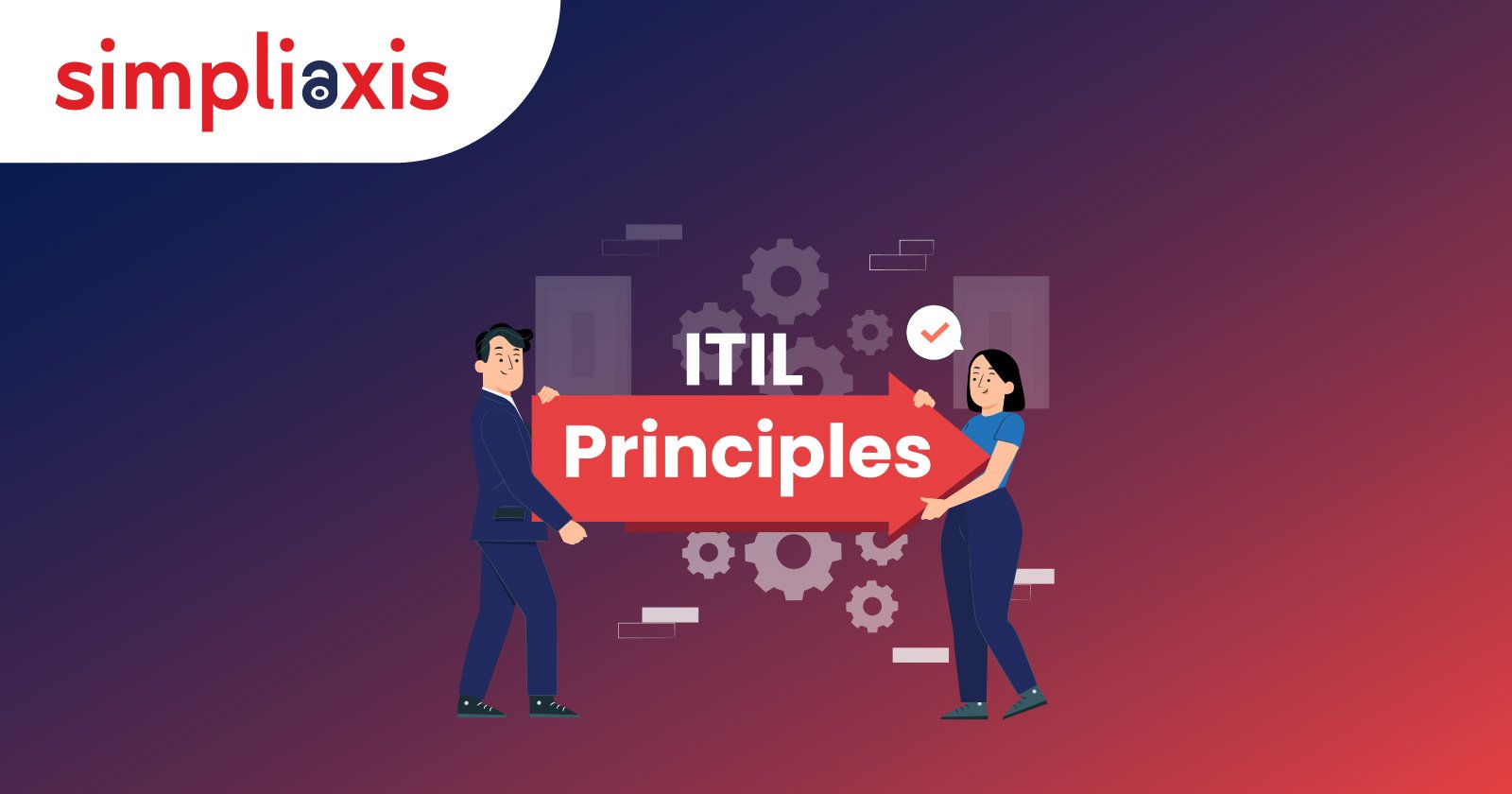Information Technology Infrastructure Library (ITIL) is the world's most widely adopted IT Service Management framework, and AXELOS owns it. These are comprehensive sets of rules, practices, and procedures that enable an organization to optimize its value delivery. Further, ITIL enhances the quality of IT service management for an organization and aims to economize costs by standardizing practices. The most updated version of ITIL is ITIL 4. ITIL 4 focuses on the Lean-Agile approach. Here, we will take a critical view of the guiding principles of ITIL 4.
Principles of ITIL:
ITIL Principles are universal recommendations that guide an organization in all circumstances. While the business environment and challenges an organization faces keep changing, adherence to ITIL principles enables it to adapt systematically. ITIL principles are not specific to any organization or technology. Instead, they should be applied to an organization's strategy, delivery of value, and maintaining a minimum level of competence. The importance of these principles underscores the need for all members of an organization to be aware of them. Members should aid in the implementation of ITIL principles in their everyday activities. First, we will briefly list these principles and then discuss their applications.
The 7 ITIL guiding principles are:
- Focus on value
- Start where you are
- Progress iteratively with feedback
- Collaborate and promote visibility
- Think and work holistically
- Keep it simple and practical
- Optimize and automate
1. Focus on Value
The goal of any organization is the delivery of value for its stakeholders. At first blush, an organization may limit its understanding of stakeholders to only its customers and shareholders. However, a more expansive view may also be adopted, including society, employees, etc. A value-oriented process makes it essential for an organization to identify its stakeholders and needs. ITIL 4 enables organizations to quicken their value delivery by using the Service Value System and integrating areas that connect varied practices into an integrated whole. 'Value' is the outcome of all of an organization's members, processes, and use of technology. ITIL 4 emphasizes the need to co-creating value with all stakeholders. Here, value is not limited to financial value but the customer or user experience. Focusing on value is a crucial ITIL principle that adopts the Lean-Agile approach.
2. Start Where You Are
Instead of investing resources into creating something new, an organization can economize its value delivery by using existing resources effectively. However, an organization needs to recognize situations where starting from scratch is required. 'Starting where you are' embodies a Lean-Agile mindset that aims to minimize wasteful expenditures and improve the existing value delivery mechanisms. Adherence to this ITIL principle makes it necessary for an organization to take a realistic approach towards its current architecture. The organization must also collect and analyze important metrics to decide where it can improve.
3. Progress Iteratively with Feedback
Only through repeated iterations can an organization perfect its mechanism of delivering value. This principle prescribes that organizations must not attempt to do everything at once. The approach must be to divide larger tasks into smaller and manageable ones and set smaller deadlines for the completion. Feedback is a necessary component of this iterative process. Adherence to this ITIL principle creates a healthy loop whereby an organization can adopt Lean-Agile. The Lean-Agile development mindset promotes taking smaller steps and confirming each with the stakeholders. A Lean-Agile method incorporates short, time-boxed iterations, framed by stakeholder engagement to endorse the value provided, instead of the 'waterfall' process approach, which uses a single monolithic cycle. The organization can use these shorter cycles to collect necessary data and metrics. Apart from stakeholder feedback, internal metrics act as waypoints for the organization to improve the delivery of its upstream and downstream services. Data also enables the organization to build trust among its stakeholders and map its progress.
4. Collaborate and Promote Visibility
Organizations that make their members work in silos become highly skilled at a single activity. However, these members suffer from a disadvantage as the business environment changes. When organizations create environments for their members to collaborate regularly, they see an overall benefit. In psycho-social terms, they see an increase in their self-worth, colleagues, and other business stakeholders they interact with. Through collaboration, members in an organization can create far greater value than those who work in isolation. Collaboration requires an environment of trust and honesty. Work and responding to challenges develop inconsistencies if incorrect information about a task is shared among members. A common knowledge base is essential to set up to avoid such situations. Collaboration isn't only for members of an organization alone; it also applies to customers, users, suppliers, and anyone else who is connected with your organization.
5. Think and Work Holistically
An integrated and holistic approach is necessary to adhere to Lean-Agile principles. It may be convenient to adopt a siloed approach and focus on individual parts of the value delivery pipeline alone, but this leads to unsatisfactory outcomes. It may not be fruitful for one department to function faster or more efficiently if it puts a load on another department. Unless an organization works on its service as a whole, not simply in its separate parts, the results arrived at by the service provider and service customer will be harmed. Internal and external customers receive results from the effective and efficient management and dynamic integration of information and technology, organizational principles, rules and procedures, stakeholders, all of which should be coordinated to produce a specified value towards the greater purpose. The organization must address how individual efforts add to the overall value generation. Adopting a holistic approach allows an organization to make decisions that benefit everyone. There is no such thing as a stand-alone service, method, department, or provider in today's world. They all interact in intricate ways in the production of value. Thus, an organization must consider the entire picture while deciding or planning for an upgrade.
6. Keep it Simple and Practical
While IT services are varied and complex, this ITIL principle emphasizes simplicity and practicality in its value delivery processes. Thus, even the most complex offerings can be simplified as per Lean-Agile principles. This principle enables an organization to rationalize its rules and procedures to respond to changing environments. One may look at an organization's management and find plenty of unnecessary regulations. Although they provide control required for compliance and regulatory requirements, they impede the free flow of information and hinder decision-making. In other words, these processes tend to slow workflow, create obstacles, and occasionally significantly hinder delivering quality and value on time. When these processes become the objective rather than the outcomes that provide genuine value, it severely undermines an organization's capabilities. DevOps and Agile workers are adjusting to new approaches to eliminate waste and boost workflow for all value streams using Lean-Agile methods. As ITIL 4 focuses on Lean-Agile, it dictates that sufficient autonomy must be provided to the members of an organization. Thus, an organization should look at its system processes and procedures to cut down on micro-managerial rules and simplify them.
7. Optimize and Automate
The ITIL principle of 'optimize and automate' is similar to the adage used in the manufacturing sector. When applied to the distribution of IT services, the same techniques that work in manufacturing will enable an organization to respond faster and offer higher quality products and services. Customers want an organization to react quickly to their constantly changing needs. Sometimes no emphasis is put on the customer experience (CX), and that can impede the delivery of value. The organization must simplify its processes to maximize its resources. Today's organizations must offer value faster while maintaining their product's quality, availability, and security. If an organization continues to build on an inflexible or complicated value delivery system, it will never achieve quicker value delivery. Automation is to be used synergistically to reduce costs like time costs associated with decision-making, labor costs, and liability costs associated with a mismatch between the organization and its stakeholders' expectations. Finally, an organization's internal data collected must be utilized for any automation to produce predictable and accurate outcomes.
Also, Check:
Conclusion
Organizations need to evolve constantly to changing situations, and customer needs in a rapidly changing world. Thus, adopting Lean-Agile has been a trend seen in organizations that successfully respond to these challenges. ITIL 4 is guided by principles that embody the Lean-Agile approach. ITIL principles are to be applied contextually and produce different outcomes depending upon the organization and the ability of its members. An organization should not pick one or two directions to adopt; instead, it should analyze the importance of each one and how they interact. The seven ITIL principles are interconnected and reliant on one another. Further, adherence to guiding principles should be examined regularly. Organizations may conduct short-term audits and maintain checklists as a part of their rules and procedures to check compliance. The universal applicability of these seven ITIL guiding principles makes them indispensable as they act as valuable tools while planning and reorganizing resources and all stakeholder interactions. Simpliaxis offers courses, including ITIL 4 Foundation Certification Training, that equip professionals with the knowledge and skills to effectively implement Lean-Agile principles like those found in ITIL 4, ensuring they can navigate the complexities of today's dynamic business environment with confidence













 +1-361-998-9988
+1-361-998-9988


